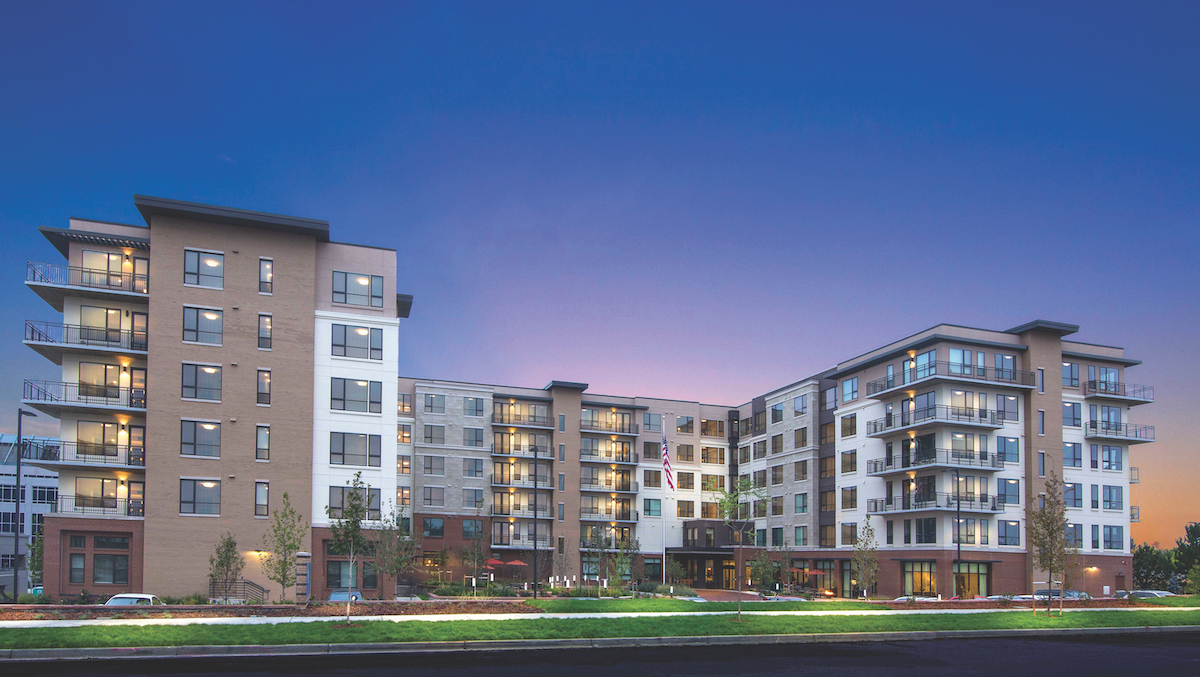Enter The Carillon at Belleview Station from the streets of Denver’s bustling Tech Center District, and your first impression is of a residence that is contemporary, sleek, and upscale. The sliding glass doors open to a quartz-and-wood reception desk with a staggered row of pendant lights overhead and a striking abstract painting on the wall. A floor-to-ceiling stone-look porcelain tile wall is accented with a greenery-filled window that peers into the expansive lobby.
The colors are fun. The finishes are fresh. The feel is energized urban living. This is senior living with style.
“It’s beautiful, but the beauty is very functional, very modern,” said Angie Erickson, General Manager of the 173,000-sf complex, which has 139 independent and assisted-living suites and 24 memory care suites. “I’ve been in the residential industry 17 years, and this is the most conducive environment I’ve ever worked in.”
“We’re always trying to change the perception of what senior living is,” said Shauna Revo, Associate and Project Design Manager at StudioSIX5, the interior design firm for The Carillon at Belleview Station.
Communities for the 55+ set are changing, said B. Dean Maddalena, AIA, NCARB, IIDA, ASID, NEWH, President of Austin, Texas–based StudioSIX5, which he founded in 2003 and which specializes in interior design for senior living. “Senior communities used to be about seclusion and security,” he said. “Now, seniors want to be in the city, integrating with the surrounding community. It’s a huge, positive shift.”
StudioSIX5 has completed more than 400 senior living projects in 34 states and the District of Columbia, from active adult communities to memory care centers. The firm recently compiled 11 trends that Maddalena believes will guide design decisions in senior living communities.
1. Senior living residential style will be more eclectic. Seniors are ready for variety in furnishings and finishes, more layering of patterns, said Maddalena. “By this time in their lives, people have traveled, they’ve been everywhere,” he said. “They realize that one room doesn’t have to be all Chippendale. It can be a mix of styles.”
2. Senior living communities are taking advantage of open floor plans. “It used to be that every activity needed its own room, which sat empty most of the day,” said Maddalena. That’s changed. The movie room can also serve as the chapel, the lecture hall, a meeting room, or a training room. “We don’t really have libraries in our senior communities anymore,” he said. “It’s more like a Starbucks with magazines.”
The Carillon’s dining room is outfitted with sliding doors that open up access to the private family dining room, the activity room, and the theater. “It’s phenomenal when you have events,” said Erickson. “You’re not trying to shove people into little rooms.”
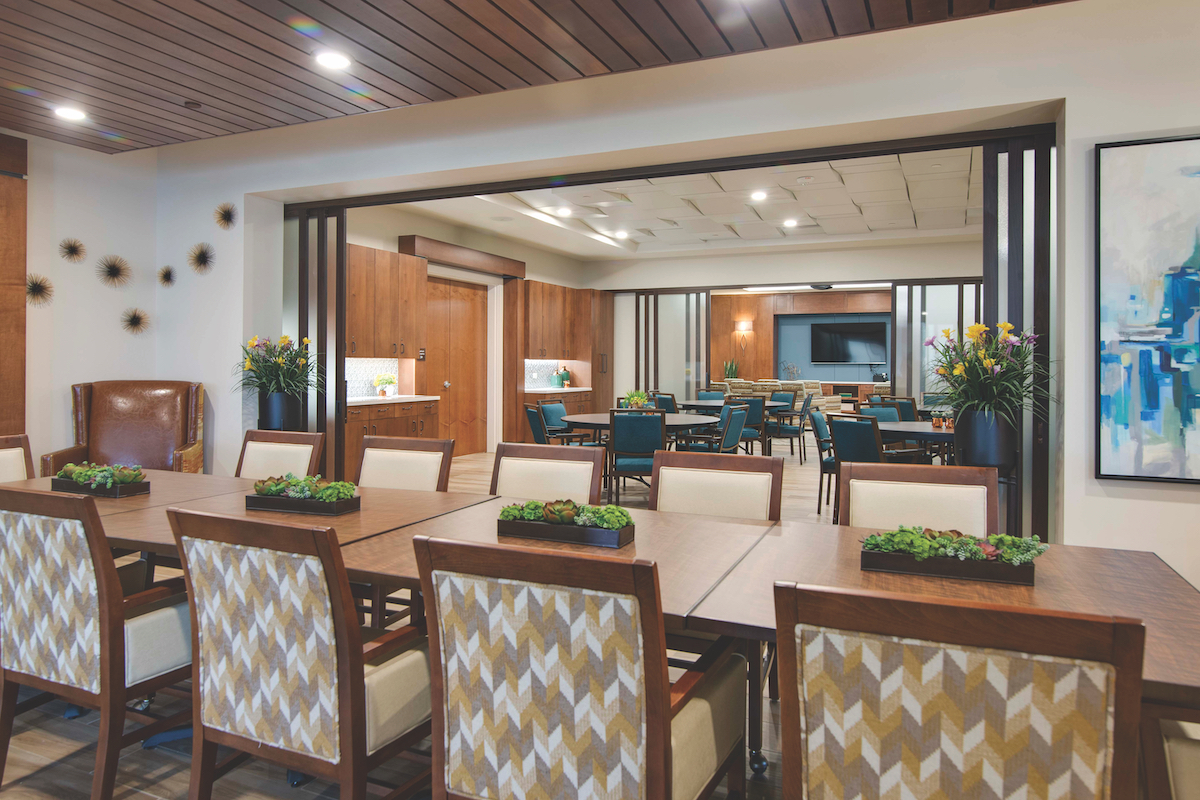
#2 Open Floor Plan. Photo: Michael Lowry Photography
3. Crisp jewel tones will gain in popularity for paint, furnishings, and accessories. Jewel tones and saturated colors permeate StudioSIX5’s communities, from upholstered chairs and draperies to decorative pillows and curated art.

#3 Jewel tones and saturated colors. Photo: Michael Lowry Photography
4. Cool-toned grays and silver accents will shift to warmer neutrals and metallics in finish selections. The once ubiquitous gray is moving toward a “beige/gray in-between,” Maddalena said. He and his team test how colors relate to seniors’ changing visual capabilities. “We wear yellow glasses to simulate how the changes in seniors’ corneas affect how they see colors,” he said. “Gray doesn’t look much like anything. When you introduce beige, it mellows everything out for the more saturated colors.”
Metallic finishes fit well with clean, contemporary design; they add heightened luxury and an organic quality. Metallics are showing up in lighting fixtures, consoles, side tables, and upholstered seating areas.
5. Digitally printed materials will bring heightened personalization to senior living design. “We can print photos on laminate and make custom countertops,” said Maddalena. The firm has printed a resident’s face on a pillow and presented it as a gift. They’ve photo-reproduced the Chicago skyline and upholstered it on a banquette, and used the same technique to make a carpet that looks like grass.
6. Lighter wood tones are gaining popularity in furnishings and millwork. “The pendulum is swinging away from dark, dark woods,” said Maddalena. Now it’s more mid-tones and browns—natural walnut, birch, ash, and natural rift-cut oak—for cabinetry millwork in reception desks, dining areas, and individual apartment kitchens.
7. Services and amenities should integrate 55+ residents with the community. As active seniors looking for independent and assisted living gravitate to urban centers to take advantage of restaurants, shops, entertainment, and healthcare, there’s a growing emphasis on providing amenities that draw in the public to help residents feel engaged with their neighbors. The Carillon’s hair salon is open to—and popular with—the public, and its sixth-floor sky lounge can be rented out for functions.
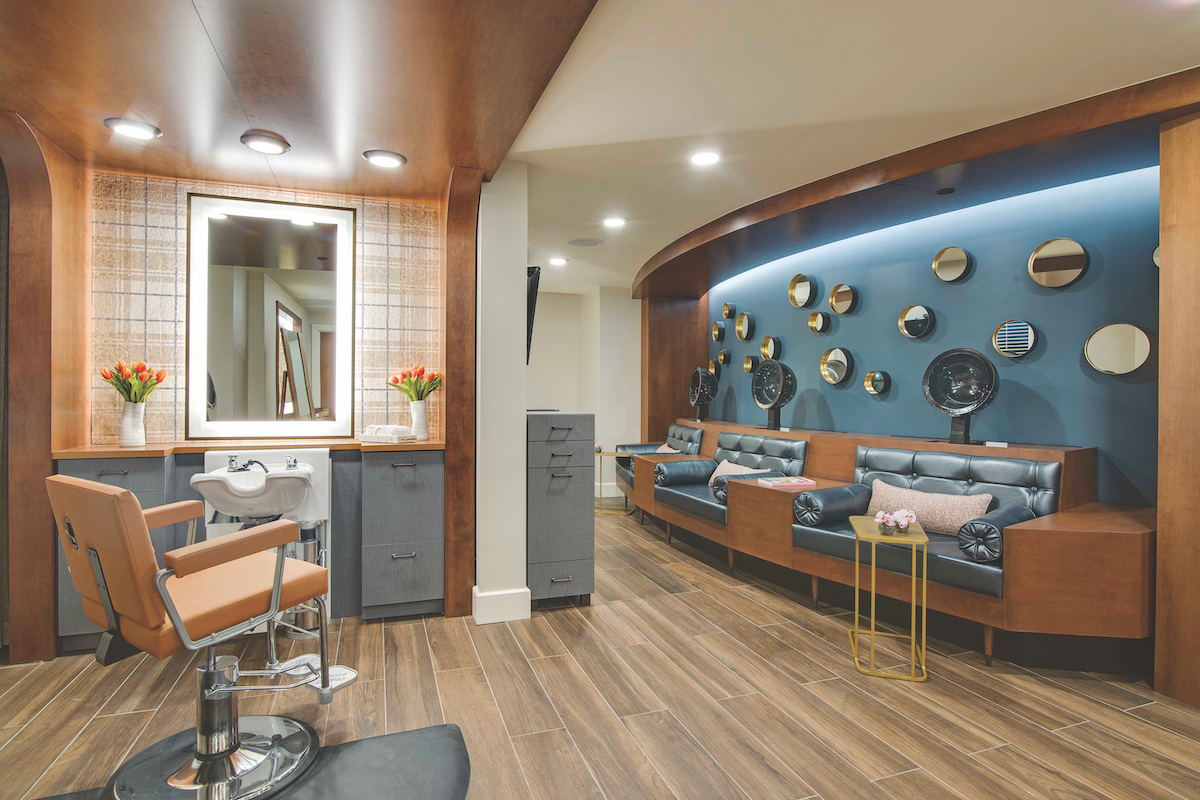
#7 Services and amenities. Photo: Michael Lowry Photography
8. Senior living communities will create more outdoor amenity “destinations.” Outdoor spaces should be an integral part of activity programming, even in hot climates. An outdoor theater with lawn chairs, where residents can watch a movie and have dinner and cocktails; a greenhouse with a gardening club; or dining spaces where residents can cook for themselves and host parties—spaces like these enliven the 55+ residential experience.
“We work on a cooking function, a lounging function, a fire pit, and a pool,” said Claire Richards, a StudioSIX5 Senior Associate who led the design team for the Overture Barrett, a 55+ community in Kennesaw, Ga. “It’s about making that another living space.” Pergolas, fountains, large-screen TVs, grills, and green lawns for yoga, bocce, or cornhole are also options. “We usually do a little pet walk along the exterior,” said Richards.
Outdoor activities should be sited so that residents can easily see from one to another. “It was once popular to spread the amenity spaces throughout the community, but we learned that out of sight was out of mind,” Maddalena said. Now, it’s important for residents to be able to see what else is going on as they engage in an activity.
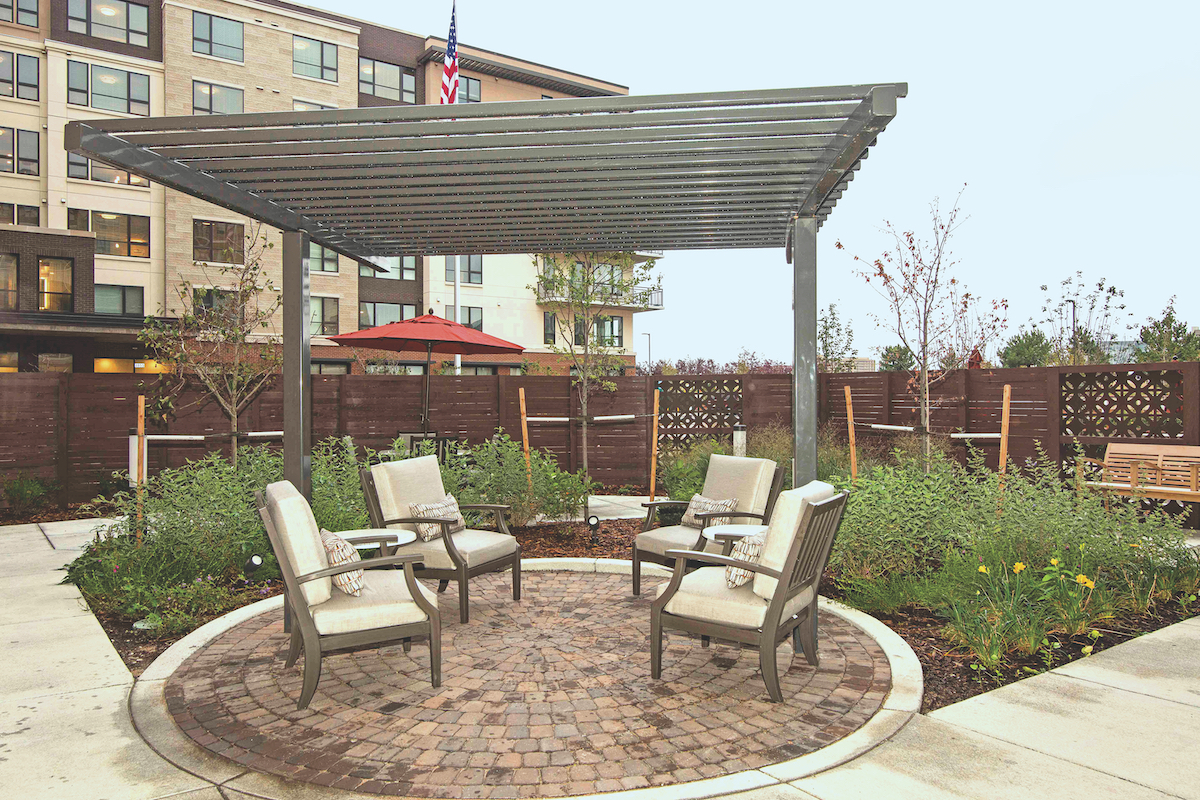
#8 Outdoor amenity destinations. Photo: Michael Lowry Photography
9. LVT and porcelain are becoming materials of choice. As recently as a few years ago, Maddalena said, StudioSIX5 would not even consider specifying wood-print luxury vinyl tile or porcelain tile: the quality just wasn’t up to the standards of the firm—or the 55+ end users. Now, LVT and porcelain are accepted market-wide, and are StudioSIX5’s go-to products for their durability, style, and affordability.
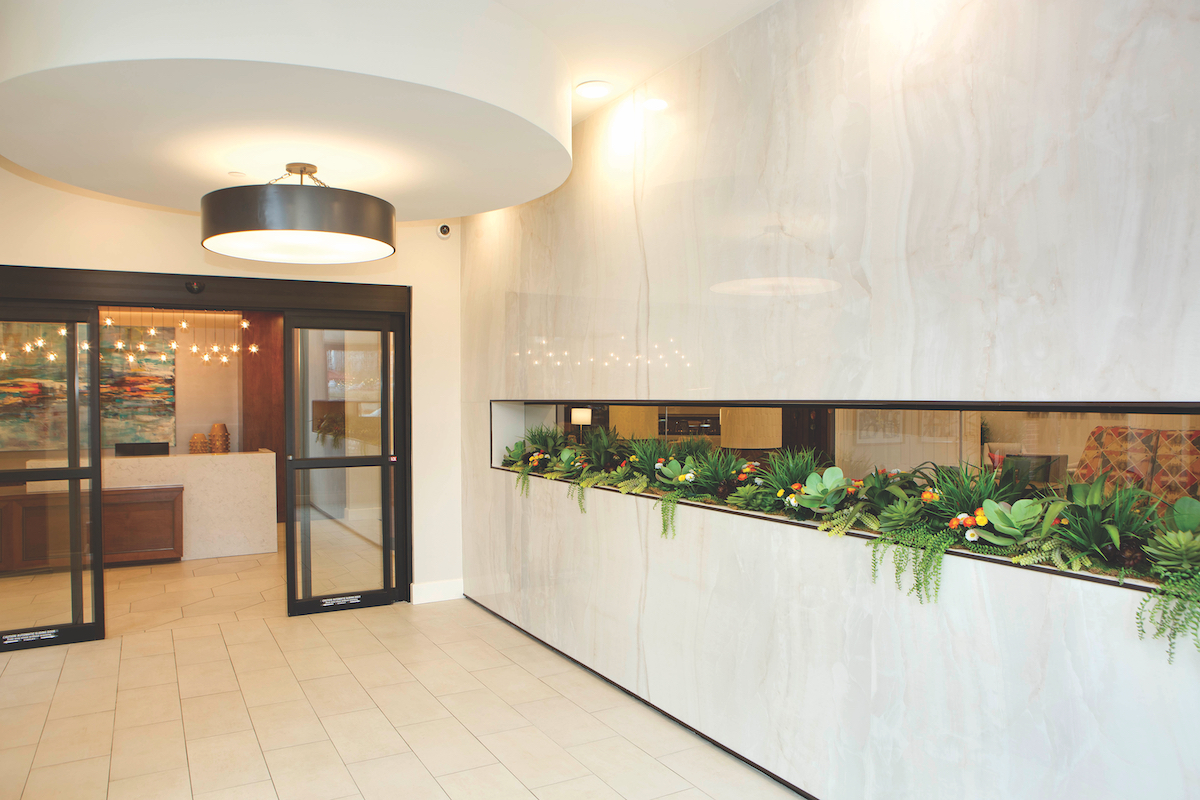
#9 LVT and porcelain tile. Photo: Michael Lowry Photography
10. Bars with self-serve point-of-service systems will rise in popularity. These systems allow residents to grab a snack or a drink, charge it on their keycard, and get a bill at the end of the month. Senior communities will still have happy hours where employees will serve the drinks, Maddalena said, but self-service is becoming more of an option. Staffing is expensive, he said, and “you want your staff focused on providing personal attention where it’s really needed.”
11. Employee amenities will need upgrading. A poorly furnished white room with vinyl floors, stuck in the back by the loading dock—welcome to the employee lounge of yesteryear. In today’s tight labor market, finding and keeping good staff is difficult, so StudioSIX5 is creating colorful, enhanced employee spaces with more care in the design and the choice of materials.
“Whether it’s a lounge with beanbag seating and a pool table, or allowing employees to use the fitness equipment, or providing child care, they want to feel like they’re cared about,” Maddalena said.
Build on these concepts for your 55+ projects, and you’ll be creating senior living communities that anyone would love to call home.
Related Stories
| Jan 4, 2011
Grubb & Ellis predicts commercial real estate recovery
Grubb & Ellis Company, a leading real estate services and investment firm, released its 2011 Real Estate Forecast, which foresees the start of a slow recovery in the leasing market for all property types in the coming year.
| Dec 17, 2010
Condominium and retail building offers luxury and elegance
The 58-story Austonian in Austin, Texas, is the tallest residential building in the western U.S. Benchmark Development, along with Ziegler Cooper Architects and Balfour Beatty (GC), created the 850,000-sf tower with 178 residences, retail space, a 6,000-sf fitness center, and a 10th-floor outdoor area with a 75-foot saltwater lap pool and spa, private cabanas, outdoor kitchens, and pet exercise and grooming areas.
| Dec 17, 2010
Luxury condos built for privacy
A new luxury condominium tower in Los Angeles, The Carlyle has 24 floors with 78 units. Each of the four units on each floor has a private elevator foyer. The top three floors house six 5,000-sf penthouses that offer residents both indoor and outdoor living space. KMD Architects designed the 310,000-sf structure, and Elad Properties was project developer.
| Dec 17, 2010
Vietnam business center will combine office and residential space
The 300,000-sm VietinBank Business Center in Hanoi, Vietnam, designed by Foster + Partners, will have two commercial towers: the first, a 68-story, 362-meter office tower for the international headquarters of VietinBank; the second, a five-star hotel, spa, and serviced apartments. A seven-story podium with conference facilities, retail space, restaurants, and rooftop garden will connect the two towers. Eco-friendly features include using recycled heat from the center’s power plant to provide hot water, and installing water features and plants to improve indoor air quality. Turner Construction Co. is the general contractor.
| Dec 17, 2010
Toronto church converted for condos and shopping
Reserve Properties is transforming a 20th-century church into Bellefair Kew Beach Residences, a residential/retail complex in The Beach neighborhood of Toronto. Local architecture firm RAWdesign adapted the late Gothic-style church into a five-story condominium with 23 one- and two-bedroom units, including two-story penthouse suites. Six three-story townhouses also will be incorporated. The project will afford residents views of nearby Kew Gardens and Lake Ontario. One façade of the church was updated for retail shops.
| Dec 7, 2010
Prospects for multifamily sector improve greatly
The multifamily sector is showing signs of a real recovery, with nearly 22,000 new apartment units delivered to the market. Net absorption in the third quarter surged by 94,000 units, dropping the national vacancy rate from 7.8% to 7.1%, one of the largest quarterly drops on record, and rents increased for the second quarter in a row.
| Nov 3, 2010
Senior housing will be affordable, sustainable
Horizons at Morgan Hill, a 49-unit affordable senior housing community in Morgan Hill, Calif., was designed by KTGY Group and developed by Urban Housing Communities. The $21.2 million, three-story building will offer 36 one-bed/bath units (773 sf) and 13 two-bed/bath units (1,025 sf) on a 2.6-acre site.
| Nov 3, 2010
Rotating atriums give Riyadh’s first Hilton an unusual twist
Goettsch Partners, in collaboration with Omrania & Associates (architect of record) and David Wrenn Interiors (interior designer), is serving as design architect for the five-star, 900-key Hilton Riyadh.
| Nov 1, 2010
Sustainable, mixed-income housing to revitalize community
The $41 million Arlington Grove mixed-use development in St. Louis is viewed as a major step in revitalizing the community. Developed by McCormack Baron Salazar with KAI Design & Build (architect, MEP, GC), the project will add 112 new and renovated mixed-income rental units (market rate, low-income, and public housing) totaling 162,000 sf, plus 5,000 sf of commercial/retail space.
| Nov 1, 2010
Vancouver’s former Olympic Village shoots for Gold
The first tenants of the Millennium Water development in Vancouver, B.C., were Olympic athletes competing in the 2010 Winter Games. Now the former Olympic Village, located on a 17-acre brownfield site, is being transformed into a residential neighborhood targeting LEED ND Gold. The buildings are expected to consume 30-70% less energy than comparable structures.


